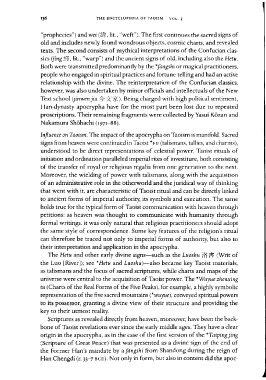Page 176 - The Encyclopedia of Taoism v1_A-L
P. 176
THE ENCYCLOPEDIA OF TAOISM VOL. I
"prophecies") and wei (~Jf, lit., "weft"). The first continues the sacred signs of
old and includes newly found wondrous objects, cosmic charts, and revealed
texts. The second consists of mythical interpretations of the Confucian clas-
sics (jing ~~, lit., "warp") and the ancient signs of old, including also the Hetu.
Both were transmitted predominantly by the *fangshi or magical practitioners,
people who engaged in spiritual practices and fortune-telling and had an active
relationship with the divine. The reinterpretation of the Confucian classics,
however, was also undertaken by minor officials and intellectuals of the New
Text school (jinwen jia 4'- Y.:. #:). Being charged with high political sentiment,
Han-dynasty apocrypha have for the most part been lost due to repeated
proscriptions. Their remaining fragments were collected by Yasui K6zan and
Nakamura Sh6hachi (1971-88).
Influence on Taoism. The impact of the apocrypha on Taoism is manifold. Sacred
signs from heaven were continued in Taoist *FU (talismans, tallies, and charms),
understood to be direct representations of celestial power. Taoist rituals of
initiation and ordination paralleled imperial rites of investiture, both consisting
of the transfer of royal or religious regalia from one generation to the next.
Moreover, the wielding of power with talismans, along with the acquisition
of an administrative role in the otherworld and the juridical way of thinking
that went with it, are characteristic of Taoist ritual and can be directly linked
to ancient forms of imperial authority, its symbols and execution. The same
holds true for the typical form of Taoist communication with heaven through
petitions: as heaven was thought to communicate with humanity through
formal writings, it was only natural that religious practitioners should adopt
the same style of correspondence. Some key features of the religion's ritual
can therefore be traced not only to imperial forms of authority, but also to
their interpretation and application in the apocrypha.
The Hetu and other early divine signs-such as the Luoshu ?41:ff (Writ of
the Luo [River]); see *Hetu and Luoshu)-also became key Taoist materials,
as talismans and the focus of sacred scriptures, while charts and maps of the
universe were central to the acquisition of Taoist power. The *Wuyue zhenxing
tu (Charts of the Real Forms of the Five Peaks), for example, a highly symbolic
representation of the five sacred mountains (*wuyue), conveyed spiritual powers
to its possessor, granting a divine view of their structure and providing the
key to their utmost reality.
Scriptures as revealed directly from heaven, moreover, have been the back-
bone of Taoist revelations ever since the early middle ages. They have a clear
origin in the apocrypha, as in the case of the first version of the *Taipingjing
(Scripture of Great Peace) that was presented as a divine sign of the end of
the Former Han's mandate by a fangs hi from Shandong during the reign of
Han Chengdi (r. 33-7 BCE). Not only in form. but also in content did the apoc-

